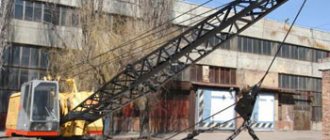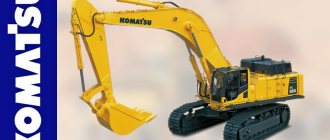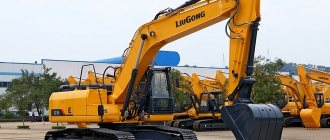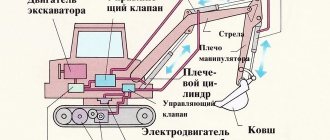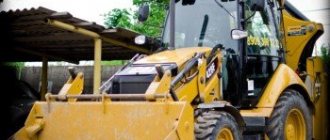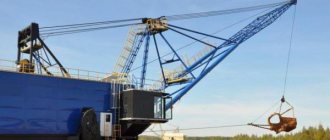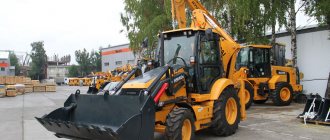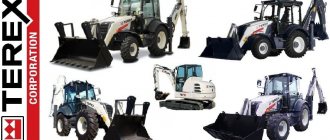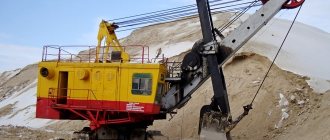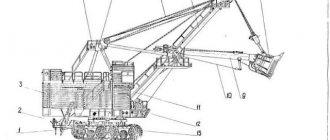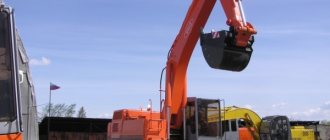Features and Benefits
The excavator is often used in peat mining enterprises.
This is due to the installation of wider tracks, which reduces the load on the base. Areas of application include construction, where the machine easily handles soils of all categories. Careful study of all design components made it possible to create equipment capable of operating in difficult conditions. Bad weather and unstable soil are not an obstacle to completing the tasks. The control system allows operators without experience to operate the EO-3223 excavator, because it is understandable on an intuitive level.
To increase productivity and implement territory planning, a “floating” boom design is provided. When cleaning channels, maximum efficiency is achieved when activating the “micro movement” mode, in which the movement speed is 200 m/h. The main part of the power in this case is transferred to the attachments.
The advantages of the 3223 single-bucket excavator are:
- ease of management and maintenance;
- stability on any type of base;
- precision control of working parts;
- durability;
- multifunctionality due to the installation of various working bodies;
- low cost of components;
- high quality;
- permeability.
Total information
The development of a new model of the EOV-4421 excavator based on the KrAZ-255B for the needs of the army began in the late 70s. At that time, the E-305 version was in production, which was equipped with a completely mechanical drive. Because of this, it had low productivity and a complete lack of reserves for modernization.
The main purpose of the KrAZ EOV-4421 was to carry out various earthworks during the construction of defensive structures and positions for troops and command and control posts. In addition, the working boom of the machine can be used to move loads weighing no more than 3000 kg. The maximum height of work does not exceed 4.5 meters.
The production of machines started at the specialized enterprise “Red Excavator” (Kiev) at the very end of the 70s and continued for about 20 years. Based on the basic model, there was an improved modification 4421A. After the collapse of the USSR, production of this machine continued for several more years under the Atek-4421A designation.
General description of the technique
The KrAZ-based excavator was developed to work in difficult terrain. The country needed a lot of earth-moving machines that could be used on large-scale construction projects taking place in remote areas. The design of the excavator is both simple and reliable. A cabin was made for the excavator operator, designed for 3 seats. The cabin frame was made of wooden beams and sheathed with sheet iron. Subsequently, the cabin was replaced with an all-metal one with insulation and interior decoration.
The “heart” of the car is a V-shaped eight-cylinder diesel engine. Each cylinder is equipped with 2 valves. To operate in the conditions of the Far North and Siberia, the vehicle has an engine pre-heater. To navigate difficult terrain, the excavator is equipped with a powerful winch.
The car has a disc clutch. The gearbox gears are in constant mesh. The gearbox is five-speed, equipped with synchronizers. 5 cardan shafts provide torque transmission to each chassis wheel. All axles are drive axles, which ensures excellent off-road and permafrost cross-country ability.
Earth-moving equipment operates on hydraulics. All components and mechanisms are made with a large margin of safety. Cases of breakdowns are extremely rare; they occur due to natural wear and tear or violation of operating rules. In the transport position, the boom is rigidly fixed to the front bumper.
Where to train to become an excavator operator
Study programs to become an excavator operator were developed by the State Committee of the Russian Federation for Vocational Education. Now they are approved by regulations of the Ministry of Education.
Now you can learn to be an excavator operator or a forklift driver not only in vocational schools, but also in training centers and manufacturing plants.
All educational institutions that teach how to operate an excavator must have an appropriate production base for conducting practical training. The practical part of the exam must take place at a tractor track and on a specially prepared route.
Education
Persons who have reached the age of 18 and have no medical contraindications for study and further work are allowed to study the profession of an excavator. A medical certificate according to the established sample is issued on a paid basis. You must also present a certificate of payment of tax (state duty established by state technical supervision authorities).
Vocational training is carried out full-time and should include:
- theoretical classes in specially equipped classrooms;
- practical lessons;
- examination events with the participation of Gostekhnadzor inspectors.
An excavator operator must be able to detect and troubleshoot problems, understand the operating principle of equipment, understand drawings, fuels and lubricants and their consumption rates, and know the basics of electrical engineering.
All this knowledge at the end of the course is checked by a certification commission, which must include a representative of Gostekhnadzor. The result of the certification is entered into the protocol. The excavator operator receives a certificate indicating the type of machine he is authorized to operate. The certificate is signed by the chairman of the examination committee.
In training centers, the course of study is designed for 300 or more academic hours and lasts from 2 to 4 months. The price is set by the centers themselves; in most educational institutions, obtaining the profession of an excavator operator costs about 7 thousand rubles, each subsequent increase in grade costs about 2.5 thousand rubles.
Increase in rank
After receiving a certificate, an excavator operator who has completed training for the first time has the right to operate a single-bucket machine with a volume of no more than 0.15 m³, since he is assigned a 4th category. To increase the rank, you will need to undergo training according to a shortened curriculum and pass an exam. Training for each higher level can be completed after a year of work with the previous qualification.
Increasing the rank indicates the professionalism of the driver. All categories and salaries of specialists are included in the unified tariff and qualification directory of jobs and professions. With each rank, wages increase, and the excavator operator receives permission to operate a more powerful machine in terms of bucket volume and productivity:
- 5th category - allows you to work with a bucket volume of up to 0.4 m³ and on trench rotary excavators with a productivity of up to 1000 m³/h;
- 6th category - bucket up to 1.25 m³, productivity - up to 2500 m³/h;
- 7th category - volume up to 4 m³, productivity up to 4500 m³/h;
- 8th category - volume up to 9 m³, productivity more than 4500 m³/h.
Powerful excavators are necessary in the mining industry, they are used in open-pit mines and coal mines. To work on such a giant, a driver needs professional education (courses will not be enough); he often works in tandem with an assistant, and a team of specialists handles the maintenance of large equipment.
Crawler excavator EO-3223
The EO-3223 excavator is a multifunctional full-rotary construction equipment equipped with a hydraulic drive. It is used when constructing new and cleaning existing canals of reclamation and irrigation systems, and during loading and unloading operations with various categories of materials.
The advantages of the machine include power, endurance of the load-bearing part, high-quality control, ease of maintenance work, and comfortable conditions in the cabin. The manufacturers of the EO-3223 excavator are Kokhanovsky EZ and Amkodor. The technology of the latter plant is more popular.
History of creation
There are not one, but several manufacturers of the EO-2621 excavator. Since 1967, this equipment has been produced in Kiev (Red Excavator), and in the Chelyabinsk region - at the Zlatoust Excavator Plant (now Zlatex LLC). And also, since 1974, in the Kyiv region - at the Borodyansky excavator plant (in our time - Borex OJSC).
Subsequently, the production of this equipment was established at a number of machine-building enterprises in the CIS. The ancestors of this universal model of earth-moving machine were the E-201 quick-release hydraulic mounted systems, based on Soviet tractors: the Lipetsk T-30 and the Minsk MTZ-2 Belarus. And later – their improved version “E-221”.
This equipment, in turn, became a continuation of the first in the Union serial mounted excavator with a hydraulic drive, developed by the VNII Stroydormash - the E-153 semi-rotary excavator, based on the MTZ-2 Belarus tractor. The manufacturer of this extremely necessary equipment in the national economy was Kiev. Each of these models was intended for a wide range of land and loading/unloading operations of medium and small volumes. And each one became a new step forward, the embodiment of a whole series of improvements. The digging depth, soil cutting force, and bucket rotation angle increased. An indicator of the high need of the Soviet Union for this technology at that time is that entire enterprises were converted into excavator factories to produce exclusively the above-mentioned models. In particular, Saransk engine repair shop; or a large workshop of the Zlatoust Mechanical Plant, which from now on were called “Saransk Excavator Plant, respectively.”
The direct predecessor of the EO-2621 was the E-2515 excavator, which in its basic version was equipped with a backhoe bucket with a capacity of 0.25 m3; the greatest digging depth was 3 m; unloading height – 2.6 m; productivity - 45-60 m3 per hour. This significantly exceeded all previous production models of mounted excavators. By the beginning of the 70s, the expanding Kyiv had already absorbed it into its city limits, surrounding it with residential neighborhoods along the perimeter. There was no place left for the construction of new workshops, and they began to be built in the village of Borodyanka, Kyiv region. Eventually, the production of mounted excavator systems for tractors was completely transferred there.
A few years later, Saransk joined Kyiv and Zlatoust, where they also launched mass production of EO-2621. Until “perestroika” and the collapse of the Soviet Union, more than twenty thousand units of this equipment were produced annually. These volumes not only covered the needs of the domestic market, but also made it possible to export EO-2621 excavators to 38 countries around the world.
Excellent performance characteristics, low cost of production and use, reliability and unpretentiousness have made the EO-2621 the main tractor-mounted excavator, the most popular in the world. This model, in its modification “EO-2621V-3”, due to its low cost and reliability, is still in production and is in stable demand on the market. Although, of course, we are not talking about previous production volumes.
Rent and purchase of single-bucket excavator EOV-4421
The EOV-4421 excavator, which is widely used in the engineering troops, can be purchased and rented both from SpetsStroy companies of Russia and from special equipment storage bases that sell them for conversion. Its cost fluctuates around 500,000 rubles. Renting this class of machines on independent wheels gives the customer a number of advantages both in terms of costs and in the performance of special-purpose work that requires precision. Rental companies have a well-established system of technical assistance and delivery of fuel and lubricants to their destination. Under the agreement, they will deliver equipment, provide trained specialists and prepare documents, which will free the customer from organizational hassle.
Numerous facts testify to the reliability of earthmoving equipment produced for the needs of the Armed Forces. Reinforced structures and improved performance characteristics make it relevant for use today.
Models based on KrAZ
The most common is the KrAZ-255 excavator. This equipment was manufactured at the Kremenchug Automobile Plant for about 26 years. Subsequently, on the basis of the world-famous car, a new model was created - the KrAZ-260 excavator.
Continuing the improvement of special equipment, the designers developed and launched the KrAZ-6322 model. This machine is equipped with modern earth-moving equipment, which makes it possible to perform a wide range of construction, agricultural and reclamation work.
KrAZ-255B excavators (which have also been produced for a long time) also continue to remain in service, being used for the construction and repair of various objects.
In memory of the merits of a reliable and trouble-free machine, a 1:43 excavator model was released on the 50th anniversary of the start of its production. Now this model is being created at the domestic enterprise “Our Avtoprom”. The use of the 1:43 scale, generally accepted in the world, allowed it to immediately become in demand.
Specifications
The performance indicators of the KrAZ excavator changed in accordance with new requirements and technologies. At the time of release, excavator equipment based on the KrAZ wheeled all-terrain vehicle was considered one of the most advanced in the world.
The technical characteristics of models 255B and 260 are as follows:
- engine power - 240-300 hp. at 2400 rpm;
- engine volume - 14.9-16.0 l;
- gearbox - mechanical with two clutch discs;
- transfer case - two-stage, mechanical with a power take-off shaft for the winch and other auxiliary equipment;
- steering - gear type with hydraulic booster;
- brakes - drum type;
- total weight with fuel and oil - 18200 kg;
- digging depth - 330 cm;
- boom range - 750 cm;
- bucket volume - 0.68 m³;
- minimum turning radius - 14.7 m;
- maximum load capacity - 2500 kg;
- elevation angle - 60º;
- fordability - 100 cm.
Today, engineers of the Kremenchug Automobile Plant continue to improve the equipment they produce. It is equipped with new modern engines, cabins and earth-moving equipment. KrAZ remains a symbol of quality.
Walking excavators:
A walking excavator is a rotating platform on a base plate with the working equipment of a walking excavator installed on it.
Additionally, the platform is equipped with paws that ensure the movement of equipment, which during operation are in a raised position (do not rest on the surface of the ground). The movement itself is carried out by lifting the base plate from the ground by lowering the paws to the ground, which is a step of the machine (mostly forward, but in some models there is also a reverse move), after which the paw is raised and returned to its original position for subsequent lowering (stroke). ). After which the cycle of movement of the walking single-bucket excavator is repeated again.
Walking excavators are usually equipped with fairly large buckets - from 15 to 40 m3, the boom reach can range from 65-150 m.
Only a dragline is used as working equipment.
Walking excavators are used:
– during stripping operations (removal of waste rock from mineral deposits);
– when developing the subsoil of the earth and minerals;
– when moving mined minerals.
General structure of EOV-4421
⇐ PreviousPage 7 of 17Next ⇒
The main parts of the EOV-4421 excavator are: the base machine, the strapping frame with outriggers, the slewing ring, the rotating platform, the power unit of the working equipment, the working equipment, the hydraulic drive, control drives and electrical equipment.
The base vehicle is the KrAZ-255B, which has been modified.
The strapping frame is designed for installing a slewing bearing and unloading (together with outriggers) the vehicle's chassis.
Outriggers are designed to unload (together with the strapping frame) the chassis of the vehicle and create the necessary stability of the machine when excavating soil and performing loading and unloading operations.
The slewing support device is designed to rotate the turntable relative to the base machine, as well as to transfer working forces from the turntable to the strapping frame.
The rotating platform is designed to accommodate the power unit, main elements of the hydraulic system, controls, excavator operator's cabin and working equipment. It serves as a frame that absorbs all the loads that arise during the operation of the excavator, and through the slewing device rests on the strapping frame.
The power plant is a source of energy for working equipment and consists of a four-stroke four-cylinder diesel engine SDM-14 (power 75 hp) with liquid cooling and systems serving it: fuel and air supply, lubrication, cooling and starting. The SDM-14 engine is started by a two-stroke starting engine PD-10U, which in turn is started by an electric starter.
The working body is a backhoe (forward) and consists of:
· unified boom;
· handles;
· ladle;
· hook suspension.
Boom – designed to install a handle with a bucket and hydraulic cylinders on it.
The handle is an elongated welded box-section structure made of the same material as the boom.
The bucket is a cutting circuit with a capacity of 0.65 m3.
Hook suspension – is an additional working equipment and is designed to perform loading and unloading operations with cargo
weighing up to 3 tons.
The hydraulic drive is designed to perform the following operations:
· transferring working equipment from transport position to working position and back;
· implementation of all working movements of working equipment when excavating pits, trenches (cracks) and when performing lifting operations;
· raising and lowering outriggers.
The main parts of the hydraulic drive are: a hydraulic tank, two hydraulic filters, a hydraulic pump, a hydraulic motor, four hydraulic cylinders of working equipment, four hydraulic cylinders of outriggers, an oil cooler, a central manifold, hydraulic distribution and valve equipment, pipelines and high-pressure hoses. The hydraulic drive of the excavator ensures the combination of the working operations of the boom, arm and bucket with the rotation of the platform, which helps to increase the productivity of the excavator.
⇐ Previous7Next ⇒
Technical characteristics of EO Excavators
Excavators EO: wheeled
EO excavators, regardless of the model, can be equipped with both the main working equipment and a number of additional devices, which include: a hydraulic hammer, a grab, three types of loading forks, a bulldozer blade, a loading bucket with a volume of 0.5, a telescopic handle, drilling equipment, and a crane suspension instead of a bucket, a backhoe with a mixed axle.
Technical characteristics of EO Excavators differ in power, dimensions and bucket volume. The EO 2621 excavator has the following characteristics:
- Length – 7700 mm;
- Width – 2400 mm;
- Height – 3800 mm;
- Operating weight – 6300 kg;
- Engine power – 59.6 kW (81 horsepower).
- Maximum transport speed – 18 km/h;
- Nominal bucket capacity – 0.1-0.28 m3;
- Maximum digging depth – 3900 mm;
- The largest digging radius is 5200 mm.
The next in the wheeled line is the EO-33211A excavator, equipped with a transmission and a diesel engine. Due to the presence of the box, the excavator can move in two gears. The model is designed for large-scale work. EO-33211A has the following technical characteristics:
- Length – 9500 mm;
- Width – 2500 mm;
- Height – 3680 mm;
- Operating weight – 18000 kg;
- Engine power – 110 kW (150 horsepower).
- Maximum transport speed – 25 km/h;
- Nominal bucket capacity – 0.42-1.05 m3;
- Maximum digging depth – 5800 mm;
- The largest digging radius is 9200 mm.
The EO-3322 excavator has smaller dimensions, but there is almost no loss in carrying capacity:
- Length – 7550 mm;
- Width – 2500 mm;
- Height – 3700 mm;
- Operating weight – 14000 kg;
- Engine power – 75 kW (96 horsepower).
- Maximum transport speed – 19.68 km/h;
- Nominal bucket capacity – 0.65 m3;
- Maximum digging depth – 4900 mm;
- The largest digging radius is 6200 mm.
Next comes the EO-3322A modification - the EO-3323 wheeled excavator with reduced dimensions and a more economical engine:
- Length – 7550 mm;
- Width – 2500 mm;
- Height – 3700 mm;
- Operating weight – 14000 kg;
- Engine power – 55.2 kW (about 75 horsepower).
- Maximum transport speed – 19.4 km/h;
- Nominal bucket capacity – 0.5-0.8 m3;
- Maximum digging depth – 5400 mm;
- The largest digging radius is 8500 mm.
EO crawler excavators
The track line begins with model 3122, which received alternative propulsors:
- Length – 7700 mm;
- Width – 2650 mm;
- Height – 3500 mm;
- Operating weight – 14500 kg;
- Engine power – 53 kW (about 74 horsepower).
- Nominal bucket capacity – 0.5-0.63 m3;
- Maximum digging depth – 4400 mm;
- The largest digging radius is 8000 mm.
The second tracked model was the EO-3223 machine; the hydraulic drive of the excavator is similar to the EO-3122 excavator, since the hydraulic systems of the excavators are almost the same. The EO crawler excavator has the following parameters:
- Length – 8700 mm;
- Width – 3200 mm;
- Height – 3100 mm;
- Operating weight – 14120 kg;
- Engine power – 74 kW (about 100 horsepower);
- Maximum transport speed – 19.4 km/h;
- Nominal bucket capacity – 0.32-0.8 m3;
- Maximum digging depth – 6500 mm;
- The largest digging radius is 9450 mm.
The new generation of crawler excavators begins with the EO-4124, for which a ripper tooth was added. There are modifications - EO-4124a and EO-41245a-07, the original model received the following characteristics:
- Length – 10500 mm;
- Width – 3170 mm;
- Height – 4000 mm;
- Operating weight – 32000 kg;
- Engine power – 132 kW (180 horsepower);
- Maximum transport speed – 3.5 km/h;
- Nominal bucket capacity – 1.45 m3;
- Maximum digging depth – 6200 mm;
- The largest digging radius is 9600 mm.
The modern excavator EO-5126 is still being produced. New EO excavators, the power of which has increased significantly due to the use of foreign-made engines, received the following parameters:
- Length – 6800 mm;
- Width – 3000 mm;
- Height – 3060 mm;
- Operating weight – 25500 kg;
- Engine power – 95 kW (about 120 horsepower);
- Maximum transport speed – 2.5 km/h;
- Nominal bucket capacity – 1 m3;
- Maximum digging depth – 6000 mm;
- The largest digging radius is 6500 mm.
Get an advantageous offer from direct suppliers:
Excavator Kokhanovsky EZ EOV 4421 technical characteristics
industry » Special equipment » Excavators » Kokhanovsky EZThe Kokhanovsky excavator EZ EOV 4421 is a wheeled excavator manufactured at the Kokhanovsky Excavator Plant based on the KRAZ-255B.
Excavator Kokhanovsky
EZ EOV 4421 technical characteristics:
- Operating weight 20000 kg.
- Overall width/height/length - 2770 mm/4200 mm/9400 mm.
- Engine of working equipment: type - diesel;
- model SMD-14;
- power 55.16 kW or 75 hp. With.;
- Power reserve for diesel fuel is 10-12 hours.
- Basic machine characteristics:
- engine model YaMZ-238;
- engine power 176.52 kW or 240 hp. With.;
- transport speed 70 km/h;
- lift/roll angle in transport position - 30 degrees/15 degrees;
- diesel fuel tank capacity 330 l;
- fordability 1000 mm;
- Cruising range on diesel fuel is 500 km.
- Track 2160 mm.
- Ground clearance 335 mm.
- Turning radius 13500 mm.
- The lift/roll angle in working position is 10 degrees/6 degrees.
- Transition time from working to transport position and vice versa is 2 minutes.
- Performance:
- trench cutting 50-60 m3/h.
- bucket capacity 0.65 m3;
- digging depth 3250 mm with a bottom width of 2500 mm and 2000 mm with a bottom width of 4000 mm;
- digging radius 7340 mm;
- unloading height 4500 mm;
- the weight of the load being lifted using the equipment as a truck crane is 3000 kg with a boom reach of 3000 mm;
- hook lifting height 4500 mm;
- hook reach 3000 mm-5160 mm.
- the presence of a driver's cabin and an excavator operator's cabin, which provide a comfortable workplace, excellent visibility of the work being carried out, as well as protection from dust and gas entering the workplace;
- the presence of comfortable seats in the driver’s and excavator operator’s cabins;
- the presence of instruments for monitoring and control of equipment, which are conveniently located on the control panel, as well as compartments used for storing essential items;
- long period of operation;
- sustainability;
- high cross-country ability;
- accuracy and efficiency of work performed;
- ease of maintenance and management;
- availability of parts, maintainability;
- the ability to force the bucket into the ground, which allows you to work with frozen soil, large stones, and so on.
- engine type - diesel;
- excavation pits 60-70 m3/h;
Excavator Kokhanovsky EZ EOV 4421 technical characteristics of working equipment:
The Kokhanovsky EZ EOV 4421 wheeled excavator is used when performing excavation work with soils of categories I-IV, bulk materials, rocks, and frozen soils. This excavator is not universal, since the backhoe does not change to a straight shovel, as a result of which the soil is immersed in the bucket only when moving from top to bottom.
The pressure of the hydraulic system is generated from hydraulic pumps, which are driven by an autonomous SMD-14 engine located on a turntable. In addition to an excavator bucket, this equipment can be used with a hook, which allows it to be used as a truck crane.
The Kokhanovsky wheeled excavator EZ EOV 4421 has the following advantages:
Cabins and their equipment
In the field of cabin design and creating comfortable conditions for the operator, Japanese companies have achieved certain results through the use of a number of designs: spacious cabins with increased glass areas; comfortable shock-absorbing remote control chairs with seat belts; low-effort control levers; toughened tinted glass; control panel with electronic clock, operating hours counter, information system for monitoring parameters; stereo receiver and air conditioning (on special orders); an opening in the roof to improve visibility, covered with a lid. There is a tendency to simplify the cab shape: without a front bevel they are installed on excavators from Caterpillar, Komatsu, with a front bevel - on excavators from Liebherr, Hitachi.
Since all machines have servo control and a remote control chair, the cabin is designed with a front door. I make the front frame slide under the cab roof. On many models of cars, the cabins have additional windows (sliding windows) or lifting door windows. The instrument panels of most excavators, in addition to water and fuel level control devices, electronic clocks and operating hours counters, are equipped with an electronic information system about the operation of all diesel and hydraulic systems. On some machines, up to 24 parameters are controlled, for example, from Case. In case of deviations from the normal functioning of the main systems and mechanisms of the excavator, the electronic on-board control system notifies the operator using lamps and sound signals.
Work is underway to reduce noise levels in the cabin. As a rule, the diesel compartment is completely isolated by an independent hood or soundproofing partitions (Komatsu and others). A significant result in this direction was achieved on single-bucket excavators EO-5225 of the Voronezh plant. Thanks to the design measures taken, the noise level in the cabin is reduced to 70 dB (A), which is much lower than that of the best excavator models.
This is interesting: Single-bucket excavator EO-2621 Petushok
